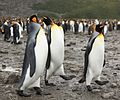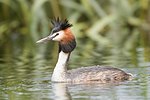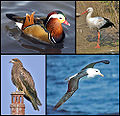Palaeognathae (/ˌpæliˈɒɡnəθi/; from Ancient Greek παλαιός (palaiós) 'old' and γνάθος (gnáthos) 'jaw') is an infraclass of birds, called paleognaths or...
46 KB (5,323 words) - 04:58, 25 March 2024
genus Struthio in the order Struthioniformes, part of the infra-class Palaeognathae, a diverse group of flightless birds also known as ratites that includes...
18 KB (1,667 words) - 16:47, 17 June 2024
other around 54 million years ago. Placement of Elephant birds within Palaeognathae, after: The ancestors of elephant birds are thought to have arrived...
34 KB (3,426 words) - 09:58, 6 August 2024
is any of a group of mostly flightless birds within the infraclass Palaeognathae. They are mostly large, long-necked, and long-legged, the exception...
43 KB (4,442 words) - 23:04, 21 August 2024
List of birds (section Subclass Palaeognathae)
al. (2014) with some clade names after Yuri, T. et al. (2013). The Palaeognathae or "old jaws" is one of the two superorders recognized within the taxonomic...
30 KB (1,950 words) - 23:55, 3 August 2024
consists of all modern birds (Neornithes or Aves) with the exception of Palaeognathae (ratites and kin) and Galloanserae (ducks, chickens and kin). Almost...
38 KB (1,339 words) - 06:17, 14 June 2024
and the flightless ratites, which belong instead to the sister taxon Palaeognathae. There are nearly 10,000 living species of neognaths. The earliest fossils...
16 KB (1,194 words) - 05:13, 6 August 2024
description of an embryonic skeleton of the extinct elephant bird, Aepyornis (Palaeognathae: Ratitae)". Journal of Vertebrate Paleontology. 27 (sup4): 1–53. doi:10...
21 KB (2,116 words) - 09:43, 20 August 2024
2014.07.001. Agnolin et al, Unexpected diversity of ratites (Aves, Palaeognathae) in the early Cenozoic of South America: palaeobiogeographical implications...
11 KB (1,106 words) - 17:50, 13 January 2024
volcanism, and landscape changes. The cladogram below is a phylogeny of Palaeognathae generated by Mitchell (2014) with some clade names after Yuri et al...
73 KB (7,890 words) - 18:46, 10 August 2024









